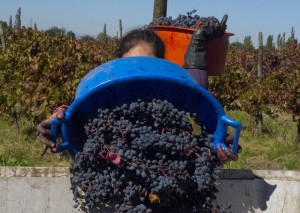By L. Antonio Liziana, CEPOC (Postharvest Study Center), Facultad Ciencias Agronómicas, Universidad de Chile
This post is part of the ADM Institute’s #PreventPHL blog campaign, following up on the First International Congress on Postharvest Loss Prevention. To read more posts in the series, click here.
The case of table grapes for export: Chile is today (2015) one of the major southern hemisphere fruit-exporting countries, and first in the world for table grape exports. About 30 years ago, the export fraction of fresh grapes was less that 50% of the production; the remnant fruit was delivered to local markets, raisins or waste. To increase the percentage of fruit for export and to reduce fruit losses, a study was designed to analyze the rejected fruits resulted from the quality selection lines in five different table grapes packing houses of AFRUCOOP, a major fruit export cooperative at that time, in the Aconcagua Valley of Chile. The volume of rejected fresh fruit was analyzed separately, grouping similar defects and deduced the cause of the defect.
Results showed out of total rejects, 65% were of sound fruit (small clusters, sound berries, small berries), and only 7.8% due to unsanitary conditions (thrips damage, oidium, and botrytis). The rest of volume included mechanical damage, water berry, lack of color, damage by birds, and dehydration.
We determined that main cause of sound fruit rejects was related mainly to deficient routine agronomical practices while the bunch was growing and developing in the field: inadequate berry, cluster and branch thinning; deficient application of GA in seedless grapes. Then at the packinghouse, the cleaners have to trim the clusters in order to give the bunch its typical commercial configuration, to fit the export box. We concluded that an additional important problem was the lack of understanding on the reason and necessity of performing their work by the field laborer.
Within the next three following years, field laborers of collaborative groves were subjected to intensive training on adequate agronomic practices, and on the understanding of the final effect of doing it precised and accurate. The laborer training included for the field workers guided visits to learn the different sections of a packing house operation. Laborers training to learn and understand the whereabouts of their work substantially reduced the losses of the fruit volume for export to less than 10%, in that period of time.
Since those early days, many things have evolved and changed in table grapes produced for export; many technological practices have been introduced and become routine, many new cultivars have improved the diversity of the export offering. But, the update and continuous training of the field laborers is still essential to produce quality table grapes grown for exports and keep lower the percentage of rejects and losses. Today, training is needed constantly for different levels of workers. It has also become essential at the supervisor and management levels.
Once you understand how losses are produced, you can help to reduce it!
The blog entries in this #PreventPHL series are by students and members of the PHL Prevention community of practice. The opinions expressed are those of the individual authors and do not necessarily reflect the position of the ADM Institute. In addition, none of the statements should be considered an endorsement of any person, product, or technique by the ADM Institute.



No comments yet.